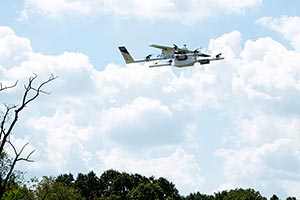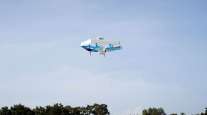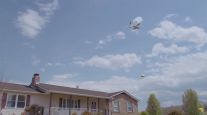Google Tests Drone Delivery With Burritos for Undergrads

Rising from the treetops, the whirring drone comes into view with its cargo tucked under the wing.
It hovers about 25 feet above a bullseye on the grass. A white trapezoidal box descends, does a little pirouette, and then lands with a plop. Agents quickly converge on the payload: a braised pork burrito.
In a closely guarded experiment involving the future of transportation, Project Wing — a division of X, founded by Google and now a child of Alphabet Inc. — is air-dropping fast food onto the campus of Virginia Polytechnic Institute and State University.
The company has invested significantly in drones and predicts that eventually they will "serve many important purposes — possibly delivering medicine and batteries to cut-off areas after a natural disaster or helping firefighters improve communication and visibility near a wildfire,” according to a fact sheet.
But there is research to be done first, and Project Wing insists it be done in semi-secrecy. It is conducting the tests off the main Virginia Tech campus in Blacksburg, Virginia, at one of the six sites approved by the U.S. Federal Aviation Administration for drone testing.
Participation is by invitation, though drop-ins are served. Professional photography and videography aren’t allowed.
On a recent sunny Friday, a couple dozen students and staff gather in Adirondack chairs and at picnic tables beneath white tents. The location, enclosed by safety nets, overlooks the Virginia Smart Road, a 2.2 mile test track managed by the Virginia Tech Transportation Institute.
Diners take a number from a red ticket dispenser and pay an extra $5.99 delivery fee to experience the dawn of unmanned Tex-Mex food delivery.
Soon, a drone emerges from the valley below, where it has picked up an order from a hidden Chipotle Mexican Grill Inc. food truck.
Volunteers and staff in gray Project Wing T-shirts keep customers behind the safety netting until their lunch is airborne. Then they are escorted to a holding area about 15 feet from the drop site, where they pause until the cargo has safely landed.
A guide escorts them to the box, a moment some capture with a selfie. Inside is a brown bag containing the burrito, still warm and in one piece.
Jenna Davis, 17, an engineering student, eloquently describes the thrill of aviation history.
“This food came out of the sky from a frikkin’ drone, and now we’re eating it,” she said.
Afterward, participants are given a Project Wing hat and are encouraged to fill out a questionnaire that asks about the quality of the food and whether they felt safe when the aircraft was near.
"How well do the following words describe the service you experienced today?" one question reads.
It’s Project Wing’s first delivery tests with actual customers in the U.S. Food was selected as a test product because it is fragile and must be delivered quickly.
The company plans to share with the FAA data on the drones’ flight path, timing and navigation, to help the regulator determine how drones should operate in public airspace.
Shelby Greenburg, an 18-year-old engineering student, said she thinks it’s “funny how innovative people are, and then we use it to deliver food.”
With a half-eaten burrito in-hand she muses. "If we aren’t using technology for what it is worth using it for, is it worth using it?”
A volunteer at the test site directs media questions to a man in aviator sunglasses who says he’s not allowed to talk to the press. He directs a reporter to another man in sunglasses who says he, too, cannot talk to the press.
Inquiries are ultimately forwarded to Jacquelyn Miller, X’s communications manager, who explains the low-profile approach. The tests are “solely focused on safety, research, and testing,” she said.
Project Wing isn’t making a profit on the operation, she said. The delivery fee is being donated to a regional food bank, Feeding America Southwest Virginia.
Ingrid Mans, 27, who works at the university’s Conservation Management Institute, said she has used photos taken by a drone to plot quail habitats. But never before has she seen a drone used for food delivery.
"That was a fun novelty to experience," said Mans, coming back from the post-delivery survey sporting a flat-brimmed Project Wing hat. "It would be cool to see it applied to more important things than fast-food delivery though."




